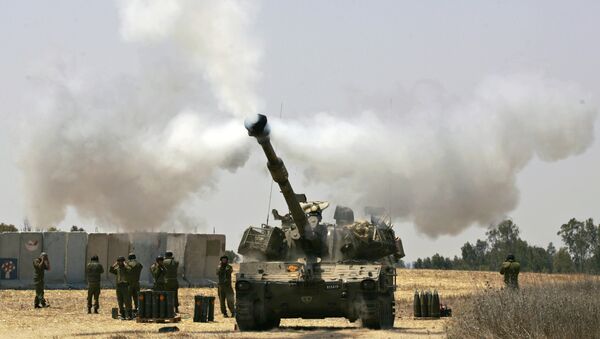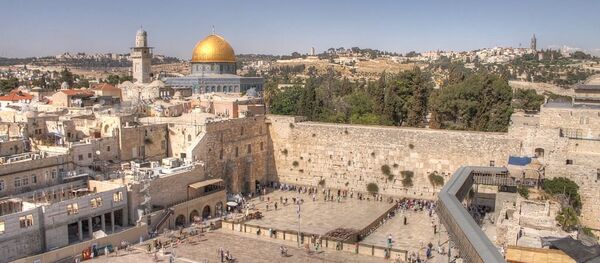The first phase of a long-anticipated ceasefire deal between Israel and the Palestinian Islamist group, Hamas, has gone into effect, raising hopes that an atmosphere of lasting calm may prevail in the Gaza Strip.
The development comes hot on the heels of reports that Egypt’s intelligence chief, Abbas Kamil, flew to Tel Aviv on Wednesday to meet with Israeli officials in an effort to broker a deal that would eliminate the possibility of another full-scale military confrontation between Hamas militants and the Israeli Defence Forces (IDF).
READ MORE: Netanyahu: No One but US Can Broker Israeli-Palestinian Peace Deal (VIDEO)
Kamil’s visit came just a day after Israel’s Channel 10 news revealed that Prime Minister Benjamin Netanyahu has shuttled his way over to the Egyptian capital, Cairo, in May, for a meeting with Egyptian strongman Abdel Fateh el-Sisi. It is believed that the two leaders exchanged visions over what a future deal for calm in the besieged Gaza Strip coastal enclave might look like.
It was also recently revealed that Qatar, a longtime backer of Hamas’ political bureau, has pledged somewhere in the region of $350 million in humanitarian aid as part of any future ceasefire agreement with Israel. Reportedly, Tel Aviv’s Defence Minister, Avigdor Liberman, held a clandestine meeting on June 22 in Cyprus with Qatar’s envoy to Gaza, Mohammad al-Amani, during which the offer was made.
The Deal: What We Know So Far
The latest announcement of an end to open hostilities — which is only the latest in a litany of ceasefire deals made over the years — is the culmination of months-long talks in Cairo between Hamas and Israeli officials, mediated by Sisi’s government and the United Nations’ Middle East peace envoy, Nikolai Mladenov.
Negotiations between the arch enemies had been on life support since the 2014 Gaza war, but were nursed back to life recently as a consequence of Egyptian and UN concerns that another round of hostilities could restart at any time after an escalation in cross-border violence.
The initiative is expected to be unfurled in a three to four-phase process. The first — which is, currently, being billed as a precursor in the form of a ‘short-term' truce — went into effect on Wednesday, while the final product is expected to be officially signed into action on Friday, August 17.
Under the agreement, Israel will commit itself to facilitate the reconstruction of Gaza, where entire neighborhoods were reduced to rubble during the 2014 confrontation, which lasted from July 8 — August 26. Additionally, Tel Aviv will lift restrictions on the Kerem Shalom commercial crossing allowing for the entry of needed aid. The opening had been closed for all but humanitarian deliveries in retaliation to border attacks by Palestinians. Israel will also allow for the expanding of the fishing zone off Gaza’s coast to nine nautical miles from six.
Above and beyond that, Israel’s Haaretz Newspaper has quoted a number of officials, speaking on condition of anonymity, as noting that other clauses to the deal exist and would be initiated, should cross-border peace prevail. These would be gradually implemented and include: medical and humanitarian assistance; the entry of foreign funds into Gaza to abet the rebuilding process; the opening of all of Gaza’s borders, including the Rafah crossing with Egypt, and discussions about building sea and airports for the strip. Allegedly, plans also exist to establish a shipping lane between Gaza and neighboring Cyprus that will be used for the delivery of food, medicine and infrastructural materials, and will be overseen by Israel for security purposes.
Yet, such overtures are by no means unconditional, with one Israeli official reportedly saying that, “only to the extent that the quiet is maintained for an extended period will Israel agree to discuss the humanitarian projects that depend upon Israel. On the condition that negotiations are also undertaken to return Israeli soldiers and civilians behind held.”
While many on both sides of the separation wall will no doubt hail the discussions as a long overdue step in the right direction, not all are content with the direction of the current diplomatic trajectory. Israel’s Education Secretary, Naftali Bennett openly rejected any deal with Hamas in the Israeli parliament as “a reward for terrorists.”
Some senior figures from Hamas, for their part, continue to routinely deny that their organization is even engaged in discussions with Israel. A senior official from the Islamist group, Taher al-Nunu, disparaged news of progress by barking that, “all the talk of an agreement that depends on Israel’s good will is a delusion and lie.” However, others, including Musa Abu Marzouk, a senior figure in Hamas’ political bureau, has confirmed that steps are underway to calm tensions with Israel.
A Challenge to the Palestinian Authority
The joint Egyptian-UN efforts are also intended to reconcile ties between Hamas, and the West Bank-based Fatah party, which heads the governing Palestinian Authority (PA). The two factions have been at each other’s throats since 2007, when they fought a brief civil war in Gaza, which resulted in the latter being ejected. Since then, attempts to reconcile have been piecemeal, with some fearing that the continued rivalry may stymie any chance of a contiguous Palestinian state being formed on both the West Bank and Gaza.
Such a possibility has not been lost on Fatah’s leader, President Mahmoud Abbas, who was reportedly enraged to learn that the United States gave the nod of approval for Egypt to mediate between Hamas and Israel “with or without the Palestinian Authority.”
In response, Abbas is said to have told Egyption officials, “you are playing in our courtyard, you are playing in Gaza against Palestinian national interests.” Following President Donald Trump’s unilateral recognition of Jerusalem as Israel’s capital in December 2017, Mr Abbas dismissed the US as having “forfeit” its traditional role as a broker of peace between Palestine and Israel and has since been reluctant to engage with Washington.
Some, however, now fear that Washington and Egypt’s bypassing of the PA is reflective of an attempt to deal with Gaza and the West Bank separately, as part of Mr Trump’s so-called ‘deal of the century,’ and that this may shatter any remaining hopes for a two-state solution unifying the two territories.
Past Peace
While the terms of the latest possible agreement to abandon confrontation appear promising on paper, it would not be the first time that optimism has raised its head, only to be hammered back down again.
As the dust was settling on Gaza following the end of 2014 war, Israeli officials and leaders from Hamas were, reportedly, almost immediately engaged in backdoor diplomacy, hashing out possible ceasefire terms. In fact, those clauses — which, evidently, never stood the test of time — contained many of the same benefits as this summer’s ostensibly new initiative, including the construction of sea and airports, as well as post-war reconstruction of Gaza’s demolished infrastructure in exchange for an end to violence across the border. However, by the summer of 2017 — three years later — little over one-third of Gaza’s 11,000 homes pulverized in the war had been rebuilt, and firefighting across the border continued unabated. In addition to Gaza ceasefire attempts in 2008 and 2012, there have been numerous plans for overall peace and reconciliation between the Israelis and Palestinians, among the most renowned being the Oslo Peace Process (1993), Madrid (1991-93) Camp David Summit (2000) and the Taba talks (2001).
Whether the fresh Egypt-UN mediated discussions will yield lasting results remains to be seen, but Israelis and Palestinians are no doubt breathing a collective sigh of relief at the prospect that maybe, this time, a ceasefire could be on the horizon.




